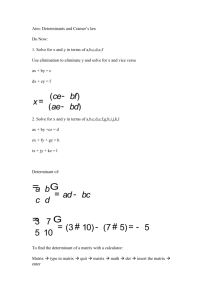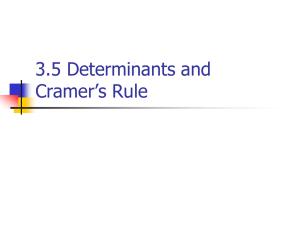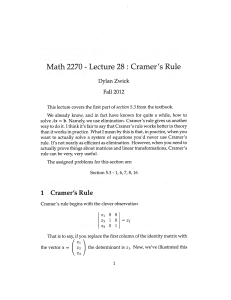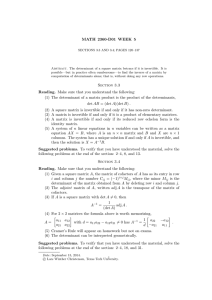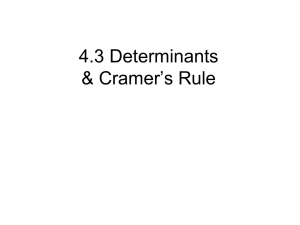Math 2270 - Lecture 28 : Cramer’s Rule Dylan Zwick Fall 2012
advertisement
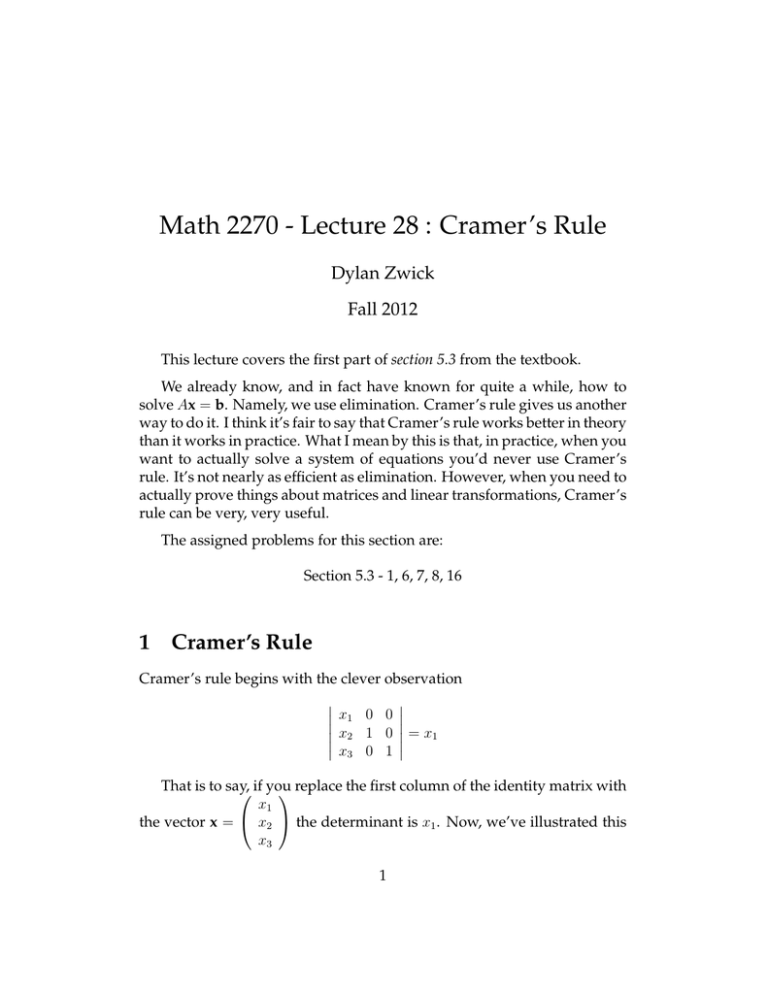
Math 2270 - Lecture 28 : Cramer’s Rule Dylan Zwick Fall 2012 This lecture covers the first part of section 5.3 from the textbook. We already know, and in fact have known for quite a while, how to solve Ax = b. Namely, we use elimination. Cramer’s rule gives us another way to do it. I think it’s fair to say that Cramer’s rule works better in theory than it works in practice. What I mean by this is that, in practice, when you want to actually solve a system of equations you’d never use Cramer’s rule. It’s not nearly as efficient as elimination. However, when you need to actually prove things about matrices and linear transformations, Cramer’s rule can be very, very useful. The assigned problems for this section are: Section 5.3 - 1, 6, 7, 8, 16 1 Cramer’s Rule Cramer’s rule begins with the clever observation x1 0 0 x2 1 0 = x1 x3 0 1 That is to say, if you replace the first column of the identity matrix with x1 the vector x = x2 the determinant is x1 . Now, we’ve illustrated this x3 1 for the 3 × 3 case and for column one, but there’s nothing special about a 3 × 3 identity matrix or the first column. In general, if you replace the ith column of an n × n identity matrix with a vector x, the determinant of the matrix you get will be xi , the ith component of x. Well, that’s great. Now what do we do with this information? Well, note that if Ax = b then A x1 0 0 b1 a12 a13 x2 1 0 = b2 a22 a23 . x3 0 1 b3 a32 a33 If we take determinants of both sides, and note the determinant is multiplicative, we get det(A)x1 = det(B1 ) where B1 is the matrix we get when we replace column 1 of A by the vector b. So, x1 = det(B1 ) . det(A) Now, again, there’s nothing special here about column 1, or about them being 3 × 3 matrices. In general if we have the relation Ax = b then the ith component of x will be xi = det(Bi ) , det(A) where Bi is the matrix we get by replacing column i of A with b. 2 Example Use Cramer’s rule to solve for the vector x: −1 2 −3 x1 1 2 0 1 x2 0 = 3 −4 4 x3 2 3 2 Calculating Inverses using Cramer’s Rule When we multiply two matrices together, the product (in the 3 × 3 case) is AB = A b1 b2 b3 = Ab1 Ab2 Ab3 . Here we’ve used two square, 3 × 3 matrices, but the idea works generally. Each column of the product is the left matrix A multiplied by the appropriate column of the right matrix B. To find the inverse of a matrix A, we want to find another matrix B such that AB = I. Writing it out for the 3 × 3 case we have A b1 b2 b3 = Ab1 Ab2 1 0 0 Ab3 = 0 1 0 0 0 1 If this is the case then B = A−1 . So, finding the inverse of an n × n square matrix A amounts to solving n equations of the form Ax1 = 1 0 0 .. . 0 , Ax2 = 0 1 0 .. . 0 0 .. . , . . . , Axn = 0 1 0 . The columns of A−1 will be the vectors x1 , . . . , xn . Well, we can find these vectors using Cramer’s rule. Going back to the 3 × 3 case, suppose we want to find (A−1 )32 . This will be the third component of the vector x2 . Cramer’s rule tells us this will be: (A−1 )32 a11 a12 0 1 a21 a22 1 . = (x2 )3 = det(A) a31 a32 0 4 We can calculate the determinant a11 a12 0 a21 a22 1 a31 a32 0 by a cofactor expansion along colum 3 to get a11 a12 0 2+3 a21 a22 1 = (−1) a11 a12 a31 a32 a31 a32 0 = (−1)2+3 det(M23 ) = C23 where M23 is the submatrix we get by eliminating column 3 and row 2 of A, and C23 is the (2, 3) cofactor of A. So, what we have is (A−1 )32 = C23 . det(A) Note that the index (3, 2) of the inverse is switched for the index (2, 3) of the cofactor. This method works generally. The component (A−1 )ij will be a11 a12 a21 a22 .. .. . . 1 a(j−1)1 a(j−1)2 aj2 det(A) aj1 a(j+1)1 a(j+1)2 .. .. . . a a n1 n2 (Aij )−1 = ··· a1(i−1) 0 a1(i+1) ··· a2(i−1) 0 a2(i+1) .. .. .. .. . . . . · · · a(j−1)(i−1) 0 a(j−1)(i+1) ··· aj(i−1) 1 aj(i+1) · · · a(j+1)(i−1) 0 a(j+1)(i+1) .. .. .. .. . . . . ··· an(i−1) 0 an(i+1) ··· ··· .. . a1n a2n .. . · · · a(i−1)n ··· ajn · · · a(j+1)n .. .. . . ··· ann . The big, narsty determinant on the right is the determinant of the matrix that we get when we replace column i by the jth column of the identity, a.k.a. the unit vector in the jth direction. Now, if we do a cofactor 5 expansion along column i of that matrix, we can see the determinant is equal to the cofactor Cji of A. Writing this result succinctly, we have (A−1 )ij = Cji . det(A) This formula works in general for any n×n matrix A. Please remember, again, that this isn’t how you’d calculate the inverse in practice. You’d use elimination. But for theoretical work this formula can be very useful. We end with some notation. For of cofactors C11 C12 C21 C22 .. .. . . Cn1 Cn2 the matrix A we can define a matrix ··· ··· .. . C1n C2n .. . · · · Cnn . The transpose of this matrix C11 C21 · · · Cn1 C12 C22 · · · Cn2 .. .. .. .. . . . . C1n C2n · · · Cnn is called the adjoint of the matrix A, or adj(A). Using this terminology we can write 1 −1 A = adj(A). det(A) We can use this to derive general formulas for an n × n determinant in the same way we derived the formula A −1 1 = ad − bc d −b −c a for a 2 × 2 matrix. However, as n gets larger, the formulas get messier and messier. 6 Example - Calculate the determinant and the adjoint of the matrix A, and use them to find the inverse of A. −1 3 2 A = 0 −2 1 . 1 0 2 7
